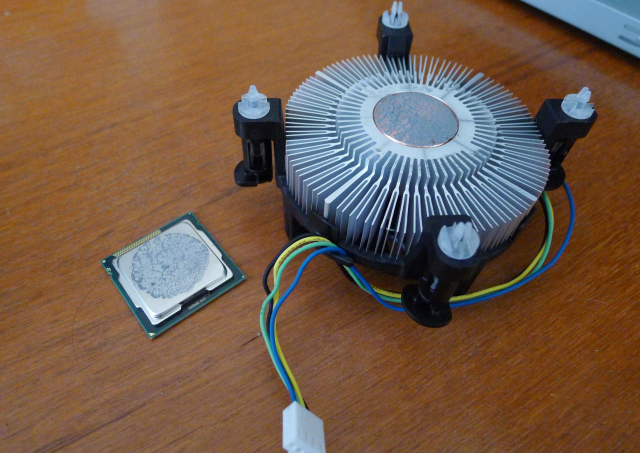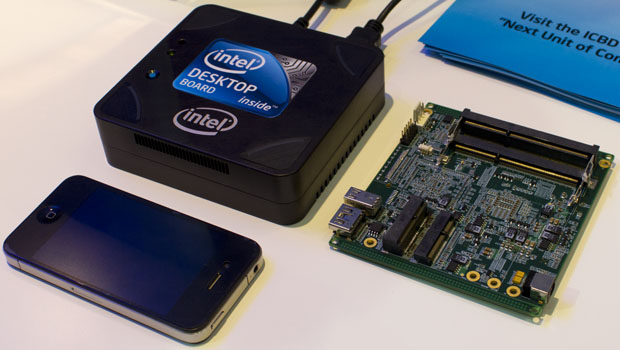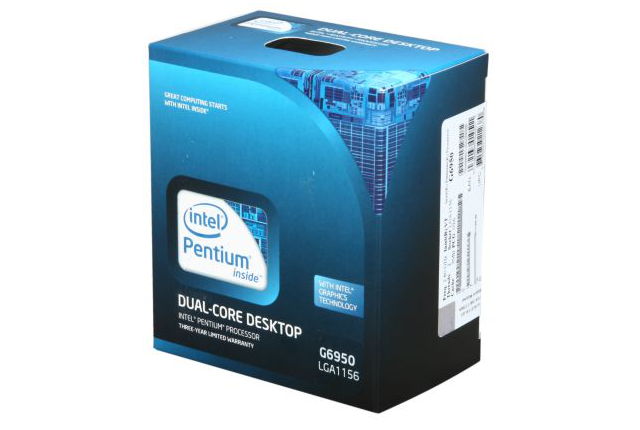
We're still waiting on Intel's next-generation Haswell CPUs to launch, but details and rumors are already swirling about processors that are even further down the company's roadmap. The latest scuttlebutt is that Broadwell, the follow-up to Haswell due in 2014, will forego standard socketed desktop processors. If the rumors are true—and both ZDNet and SemiAccurate report that they've received confirmation from PC OEMs—Broadwell desktop CPUs will need to be soldered directly to motherboards, and won't be easily swappable or upgradeable by users and system builders.
CPUs soldered to motherboards aren't anything new. While Intel-powered desktops normally use a land grid array (LGA) package to allow for OEM and end-user upgrades, laptops, all-in-ones, and other more highly integrated systems already often use soldered-on CPUs in a ball grid array (BGA) package. However, this would be the first time that this limitation would be imposed on standard desktop processors.
While this move wouldn't have much of an impact on the vast majority of desktop users, most of whom simply don't perform their own processor upgrades, there's been quite a bit of hand wringing among power users who feel that their ability to upgrade and build their own systems is in jeopardy. But are the desktop-as-we-know-it's days really numbered, or is all of this worrying much ado about nothing?
Broadwell may not be a general-purpose desktop part

The most plausible explanation for this move is that Broadwell may not be intended for traditional tower computers at all.
For the last few years, Intel's processor line has been upgraded on a predictable annual schedule, referred to by Intel as "tick-tock." Every two years, a major new processor architecture ("tock") is introduced—Haswell fills this role, as Sandy Bridge did back in 2011. New architectures are then followed up the next year by a "tick," in which Intel makes some smaller tweaks to the processor's performance and introduces new power-saving manufacturing processes. Generally, tocks are the parts that bring the big performance improvements, while ticks bring small performance increases but reductions in power usage—power usage reductions that are generally more useful for battery-powered laptops than they are for desktops.
It could be the case that Intel intends Broadwell to focus primarily on mobile computers like laptops and tablets, while continuing to sell older (but not significantly slower) Haswell parts for traditional socketed desktops. It would put technophiles in the position of not always having the latest-and-greatest powering their desktops, but its practical effect would be negligible. Broadwell's integration of the chipset into the CPU package would likely require new motherboards anyway, making the upgrade path for users who update their hardware regularly that much more expensive.
This wouldn't be the first time that Intel's mobile and desktop product lineups had been split: Intel sold Pentium M CPUs in laptops alongside Pentium 4 chips in desktops for years. A return to this path for Haswell and Broadwell is one that makes sense, since it frees up more of the company's manufacturing capacity to make higher-demand (and higher-priced) CPUs for laptops and tablets. Intel has also been known to skip architectures for certain segments of its product line when it makes sense—for example, the highest-end multisocket Xeon processors will eventually go straight from the current 32nm Westmere EX architecture to the 22nm Ivy Bridge EX, presumably because the power usage of a 32nm Sandy Bridge EX would have been too high to be palatable.
As for the motherboard-mounted Broadwell desktop parts that will exist, it could be the case that whatever Broadwell desktop CPUs make it to market will simply be targeted toward highly integrated systems like all-in-ones, or small form-factor desktop like Intel's so-called "Next Unit of Computing." These sorts of systems, which are rarely intended to be upgradeable in any event, could still benefit from the reduced heat output and lowered power consumption of Broadwell, while larger towers could still have a fast and fully upgradeable CPU in Haswell. Socketed processors may then come back for Skylake, Intel's next "tock" scheduled for release in 2015—the report from SemiAccurate believes this to be the case.
The future is murkier—whether Skylake's successor would take the same bifurcated approach as Haswell and Broadwell, and whether the LGA packaging for desktop processors would survive beyond Skylake, is unknown at this point. But Intel has tried some things in the past that could point the way forward.
Upgrading your hardware using software

Back in 2010, Intel launched a small-scale experiment with its Pentium G6951 CPU. The idea was that users could buy computers using this CPU, and then at some later date purchase a code that could unlock latent features in the processor. Users could thus "upgrade" their processor without physically needing to upgrade their processors.
Intel hasn't expanded this idea to its entire lineup—upgrade codes are also available for a few midrange Sandy Bridge processors only—but like the Broadwell announcement, the move caused quite bit of teeth-gnashing at the time. It wasn't cost-efficient compared to buying a faster processor in the first place, and some regarded the sale of a processor with intentionally disabled features as disingenuous, but it made a certain amount of sense for the people who weren't comfortable prying open their own computer cases. Buy a cheap computer now, put down a smaller chunk of change down the line to give it an easy speed boost.
In a world where CPUs come soldered onto motherboards, this approach could be utilized to give users the ability to upgrade their PCs without actually upgrading their PCs. It would require a fairly radical rethinking of Intel's tangled product matrix—I can't imagine motherboard makers would be willing to produce two dozen different motherboards for each separate processor SKU—but it gives those motherboard makers and OEMs a way to offer various products at different performance levels and price points without actually needing to sell different hardware.
This approach could potentially cause cost-increasing problems for OEMs, though—if you're selling a dual-core processor that can be upgraded into a quad-core processor, you've got to make sure that all of your systems have cooling fans and power supplies that can handle the demands of a quad-core chip. Depending on how Intel consolidated its product lineup, it could also be costly for the chipmaker: if it sell a load of CPUs that can be upgraded via software to have more cache, more cores, Hyperthreading, or other features that end users rarely take advantage of, that could add up to a whole lot of wasted silicon (and thus, money).
Still, selling CPUs and other products with disabled features isn't exactly a new phenomenon: many chips are sold with disabled cores or less cache in order to address multiple price points without actually having to design new purpose-built hardware. The best example of this is probably AMD's triple-core CPUs, which are just quad-core parts with one of the cores turned off—manufacturers often take this approach early in a new processor's manufacturing run so that they can still sell a CPU even if all of its cores aren't working as they should (a trick to increase yield rates and avoid wasting silicon), but in many cases enthusiasts can unlock these disabled features without issue. In our hypothetical scenario, Intel would merely be institutionalizing a practice that has long gone on behind the scenes.
Whatever happens, the modular desktop won't last forever
The desktop as we know it, complete with replaceable processors and user-upgradeable components, will probably still be around for at least the next few years, whatever happens with Broadwell. In the long-term, though, desktops with replaceable CPUs will probably become a thing of the past.
One of the biggest, most pervasive trends in computing is increasing integration. It arrived early in phones and tablets, where cramped physical space and tight power usage windows helped drive the integration of the CPU, GPU, memory, and other components into monolithic systems-on-chips. We've seen it move into laptops as well, where Ultrabooks and a more general push toward lighter, thinner systems has driven OEMs to shave off millimeters wherever they can. Small form factor desktops and all-in-ones (many of which actually use mobile CPUs instead of desktop CPUs anyway) have followed suit—it is arguably only a matter of time before the trend claimed the run-of-the-mill desktop, which isn't exactly a segment with high enough growth to continue meriting its own separate processors and parts indefinitely.
More than that, selling desktops with all of the parts integrated into the motherboard more accurately reflects how the vast majority of consumers use their PCs—most of them simply don't upgrade them over their useful life, and if it gets too slow, stops meeting their needs, or simply breaks, they'll either turn to an authorized repair center or replace the system outright rather than digging around in it and upgrading it themselves.
Like many of you, I've been upgrading components and building my own systems since childhood, and I get as annoyed as anyone by laptops with the RAM soldered to the motherboard or non-standard hard drive connectors and form factors, but that's the way that things are moving. In general, having fewer parts means that there are fewer things that can break, and that manufacturing costs (and, hopefully, costs to the consumer) are lower. These are the things that most users and businesses care about—the death of the user-replaceable CPU would be a sad road marker on the highway of technological progress, but the amount of impact it would actually have on computing is probably less than we'd like to think.
Listing image by Casey Johnston
reader comments
302